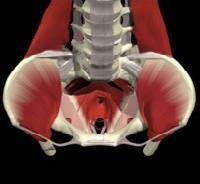The muscles of the pelvic floor evolved as a sling of muscles to help control our urethral, vaginal, and anal sphincters. Also known as the PC muscles, the pelvic floor can be envisioned like a hammock of several muscles criss-crossing over each other to form a network. They are like a make-shift “floor” under our pelvis, forming support for our intestines, bladder, and other pelvic organs (prostate for men, vagina, uterus and ovaries for women). But sometimes, these muscles can become a source of discomfort, weakness, and/or pain for millions of men and women.
Ever since we have been walking upright (maybe 6 million years now) our bodies have had increased stress in our pelvic floor because of the effects of gravity. Even though pregnancy and childbirth has always placed a strain on this network of muscles, regular physical activity and walking on all fours gives other animals advantages to strengthen these muscles that humans do not have. Added to this is the tendency of humans being not only sedentary, but also overweight. All of these factors cause the muscles of the pelvic floor to weaken over time.
When there is pelvic floor dysfunction, there can be weakness, spasticity, or cramping and knotting up of the muscles. This creates a situation where the muscles cannot work in coordination to do their function – be constricted when walking around to maintain continence, or relax when using the bathroom or engaging in sexual intercourse. When weakness or dysfunction occurs, there can be pain during sex, pain sitting for long periods of time, back pain, constipation, difficulty with urination, or pain upon urination or ejaculation.
It’s estimated that perhaps up to 20% of people may have some pelvic floor dysfunction at some time in their lives. Being overweight, not participating in regular exercise or stretching, and changes in collagen and connective tissue that can occur with pregnancy or menopause can increases the risk for developing pelvic floor dysfunction. Kegel exercises are often recommended to increase tone of PC muscles, especially for women after childbirth. But since these can worsen pelvic floor dysfunction, it is important to be evaluated for pelvic floor dysfunction if you have any pain or problems with urination, defecation, or sexual activity before starting Kegels.
An evaluation by either your gynecologist (women) or urologist (men) is in order if you feel you may have any of the symptoms mentioned above. Physical therapy is usually quite successful in treating pelvic floor dysfunction, but as always – the sooner treatment begins, the sooner and easier it can be resolved.






Leave A Comment